| The aroma of green tea
contains fresh and flowery notes, and roast notes. Generally,
the odor intensity of green tea is very weak compared
with oolong tea or black tea where large amounts of aroma
compounds are produced biochemically during the fermentation
process. |
@ |
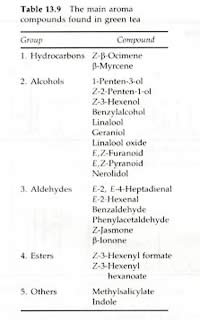 |
 |
EEffect of clone
Tea has a specific profile reflecting the genetic peculiarly
of each clone.
Recently, variations in monoterpene alcohol content
of tea volatiles have been found.
These alcohol, which have flowery aromas, are liberated
from glucosides which accumulate in tea shoots.
Variation in the contents of monoterpene alcohols,
especially linalool and geraniol and ratio of these
alcohols in defined in the Terpene Index as shown before.
Terpene Index= Linalool/(Linalool+Geraniol)
|
@ |
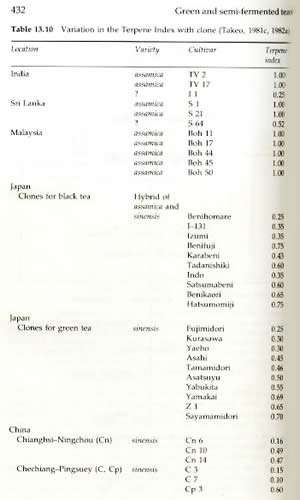 |
 |
EEffect of shading
Gyokuro and Ceremony tea have a special aroma, originally
called the rice-straw smell because it is produced by
shading tea plants with rice-straw.
It has been shown that the Gyokuro odor is associated
with dimethylsulpide which is formed during processing
by thermal degradation of S-metyl mothionine.
This precursor occurs in all fresh shoots, but accumulates
in those that are shaded.
|
@ |
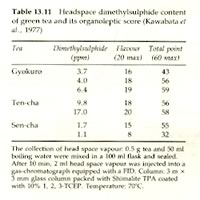
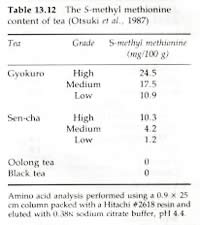 |
 |
|
EFleshy aroma
Fleshy and greenish odour notes represent the typical
aroma of green tea.The fleshy and greenish aroma is
composed of Z-3-hexenol, its esters and E-2 hexaenal.The
proportions of Z-3 hexenyl hexanoate, Z-3 hexenyl-E-"
hexanoate and Z-3 hexanol, which contribute to the typical
fleshy aroma, and of linalool and geraniol, which contribute
to the flowery aroma.
In contrast, the volatiles responsible for greenish
and flowery notes, such as Z-3 hexenyl hexanoate, geraniol
and especially linalool form a lesser proportion of
total aroma volatiles of shaded green tea than unshaded.
These facts explain why Gyokuro and Ceremony tea have
less greenish odour, but more intense rice-straw odour.Are
greater in high grade than low grade Sen-cha. Therefore,
the high grade (spring harvested) Sen-cha has a fleshy
and greenish aroma, whereas the lower grade summer tea
presents a grassy and harsh odour.
|
@ |
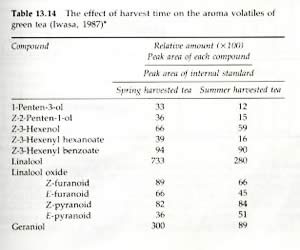 |
 |
|
ERoast aroma
Japanese green teas are heated after production so
that Japanese green tea has roast aroma.Roast aroma
is produced by pyrrols and pyrazines. Such compounds
are formed by action of heat on the free amino acids
and sugars in tea leaves during drying.
The most important roast aroma compounds of green tea
are2,5- dymethylpyrazine and 1-ethylpyroll-2- theanine
and D-xylose, respectively.
The superior roast aroma of best quality green tea
is obtained by using leaves with.
This section is difficult one however, there are very
few references that write tea aroma scientifically.
Therefore I wrote this section.
|
@ |
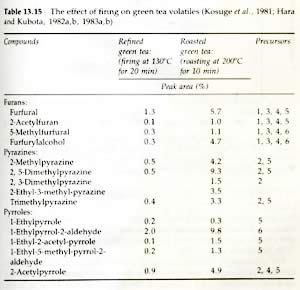 |
 |
 |
 |
|

